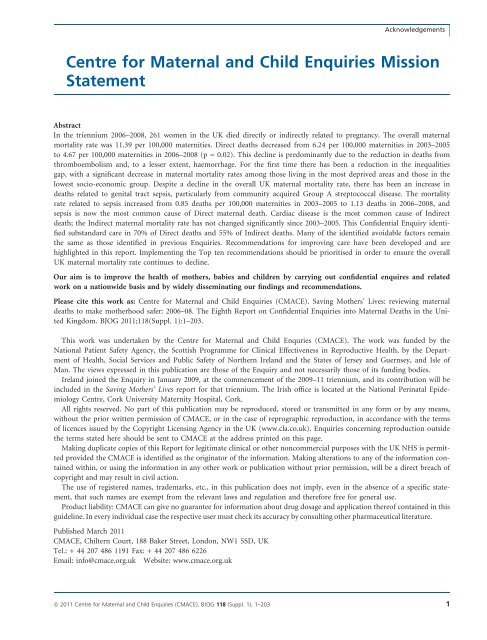6.-March-2011-Saving-Mothers-Lives-reviewing-maternal-deaths-to-make-motherhood-safer-2006-2008
6.-March-2011-Saving-Mothers-Lives-reviewing-maternal-deaths-to-make-motherhood-safer-2006-2008
6.-March-2011-Saving-Mothers-Lives-reviewing-maternal-deaths-to-make-motherhood-safer-2006-2008
Create successful ePaper yourself
Turn your PDF publications into a flip-book with our unique Google optimized e-Paper software.
AcknowledgementsCentre for Maternal and Child Enquiries MissionStatementAbstractIn the triennium <strong>2006</strong>–<strong>2008</strong>, 261 women in the UK died directly or indirectly related <strong>to</strong> pregnancy. The overall <strong>maternal</strong>mortality rate was 11.39 per 100,000 maternities. Direct <strong>deaths</strong> decreased from <strong>6.</strong>24 per 100,000 maternities in 2003–2005<strong>to</strong> 4.67 per 100,000 maternities in <strong>2006</strong>–<strong>2008</strong> (p = 0.02). This decline is predominantly due <strong>to</strong> the reduction in <strong>deaths</strong> fromthromboembolism and, <strong>to</strong> a lesser extent, haemorrhage. For the first time there has been a reduction in the inequalitiesgap, with a significant decrease in <strong>maternal</strong> mortality rates among those living in the most deprived areas and those in thelowest socio-economic group. Despite a decline in the overall UK <strong>maternal</strong> mortality rate, there has been an increase in<strong>deaths</strong> related <strong>to</strong> genital tract sepsis, particularly from community acquired Group A strep<strong>to</strong>coccal disease. The mortalityrate related <strong>to</strong> sepsis increased from 0.85 <strong>deaths</strong> per 100,000 maternities in 2003–2005 <strong>to</strong> 1.13 <strong>deaths</strong> in <strong>2006</strong>–<strong>2008</strong>, andsepsis is now the most common cause of Direct <strong>maternal</strong> death. Cardiac disease is the most common cause of Indirectdeath; the Indirect <strong>maternal</strong> mortality rate has not changed significantly since 2003–2005. This Confidential Enquiry identifiedsubstandard care in 70% of Direct <strong>deaths</strong> and 55% of Indirect <strong>deaths</strong>. Many of the identified avoidable fac<strong>to</strong>rs remainthe same as those identified in previous Enquiries. Recommendations for improving care have been developed and arehighlighted in this report. Implementing the Top ten recommendations should be prioritised in order <strong>to</strong> ensure the overallUK <strong>maternal</strong> mortality rate continues <strong>to</strong> decline.Our aim is <strong>to</strong> improve the health of mothers, babies and children by carrying out confidential enquires and relatedwork on a nationwide basis and by widely disseminating our findings and recommendations.Please cite this work as: Centre for Maternal and Child Enquiries (CMACE). <strong>Saving</strong> <strong>Mothers</strong>’ <strong>Lives</strong>: <strong>reviewing</strong> <strong>maternal</strong><strong>deaths</strong> <strong>to</strong> <strong>make</strong> <strong>motherhood</strong> <strong>safer</strong>: <strong>2006</strong>–08. The Eighth Report on Confidential Enquiries in<strong>to</strong> Maternal Deaths in the UnitedKingdom. BJOG <strong>2011</strong>;118(Suppl. 1):1–203.This work was undertaken by the Centre for Maternal and Child Enquries (CMACE). The work was funded by theNational Patient Safety Agency, the Scottish Programme for Clinical Effectiveness in Reproductive Health, by the Departmen<strong>to</strong>f Health, Social Services and Public Safety of Northern Ireland and the States of Jersey and Guernsey, and Isle ofMan. The views expressed in this publication are those of the Enquiry and not necessarily those of its funding bodies.Ireland joined the Enquiry in January 2009, at the commencement of the 2009–11 triennium, and its contribution will beincluded in the <strong>Saving</strong> <strong>Mothers</strong>’ <strong>Lives</strong> report for that triennium. The Irish office is located at the National Perinatal EpidemiologyCentre, Cork University Maternity Hospital, Cork.All rights reserved. No part of this publication may be reproduced, s<strong>to</strong>red or transmitted in any form or by any means,without the prior written permission of CMACE, or in the case of reprographic reproduction, in accordance with the termsof licences issued by the Copyright Licensing Agency in the UK (www.cla.co.uk). Enquiries concerning reproduction outsidethe terms stated here should be sent <strong>to</strong> CMACE at the address printed on this page.Making duplicate copies of this Report for legitimate clinical or other noncommercial purposes with the UK NHS is permittedprovided the CMACE is identified as the origina<strong>to</strong>r of the information. Making alterations <strong>to</strong> any of the information containedwithin, or using the information in any other work or publication without prior permission, will be a direct breach ofcopyright and may result in civil action.The use of registered names, trademarks, etc., in this publication does not imply, even in the absence of a specific statement,that such names are exempt from the relevant laws and regulation and therefore free for general use.Product liability: CMACE can give no guarantee for information about drug dosage and application thereof contained in thisguideline. In every individual case the respective user must check its accuracy by consulting other pharmaceutical literature.Published <strong>March</strong> <strong>2011</strong>CMACE, Chiltern Court, 188 Baker Street, London, NW1 5SD, UKTel.: + 44 207 486 1191 Fax: + 44 207 486 6226Email: info@cmace.org.uk Website: www.cmace.org.ukª <strong>2011</strong> Centre for Maternal and Child Enquiries (CMACE), BJOG 118 (Suppl. 1), 1–203 1


